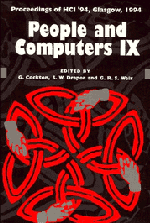Book contents
- Frontmatter
- Contents
- Preface: HCI'94 – You Probably Haven't Seen It All Before
- Part I Invited Papers
- Part II Methodology of Interactive Systems Development
- Crafting Interaction: Styles, Metaphors, Modalities and Agents
- Modelling Humans, Computers and their Interaction
- 18 Multi-Perspective Modelling of Interface Design Issues: Undo in a Collaborative Editor
- 19 Qualitative Models of User Interfaces
- 20 Modelling Interaction using Template Abstractions
- 21 The Formal Analysis of Human-Computer Interaction During Accident Investigations
- Notations and Tools for Design
- Part VI Computer-Supported Cooperative Work
- Author Index
- Keyword Index
19 - Qualitative Models of User Interfaces
Published online by Cambridge University Press: 04 August 2010
- Frontmatter
- Contents
- Preface: HCI'94 – You Probably Haven't Seen It All Before
- Part I Invited Papers
- Part II Methodology of Interactive Systems Development
- Crafting Interaction: Styles, Metaphors, Modalities and Agents
- Modelling Humans, Computers and their Interaction
- 18 Multi-Perspective Modelling of Interface Design Issues: Undo in a Collaborative Editor
- 19 Qualitative Models of User Interfaces
- 20 Modelling Interaction using Template Abstractions
- 21 The Formal Analysis of Human-Computer Interaction During Accident Investigations
- Notations and Tools for Design
- Part VI Computer-Supported Cooperative Work
- Author Index
- Keyword Index
Summary
Analogy is an important factor in learning unfamiliar computer systems and problem solving when using those systems. Designers of computer systems can aid novice users by exploiting analogies and explicitly representing a model world with which the users are familiar as part of the user interface. Objects in the model world, and some operations that may be performed on them, are often analogous to those in the real world. We consider the qualitative reasoning approach to modelling people's knowledge of the real world and attempt to build qualitative models of objects and operations in the model world of a user interface. These models reveal features of existing systems that cannot be explained in terms of users' knowledge of the real world and suggest limits to direct engagement with on-screen objects.
Keywords: analogy, qualitative reasoning, direct engagement.
Introduction
Two principle paradigms have been employed in designing user interfaces to interactive computing systems, the ideas of the conversation metaphor, and the model world metaphor. In the conversation metaphor, users and systems engage in a dialogue, using languages of various complexities, about some unseen, but assumed, task domain. In the model world metaphor, the task domain is explicitly represented on-screen. Even with these direct manipulation interfaces, when users encounter them for the first time, as Carroll & Thomas (1982) suggest, by definition they do not have the knowledge required to successfully use the system. Instead, related knowledge is employed and is used as a metaphor for the material being acquired.
- Type
- Chapter
- Information
- People and Computers , pp. 261 - 272Publisher: Cambridge University PressPrint publication year: 1994
- 1
- Cited by



